Past Presidents
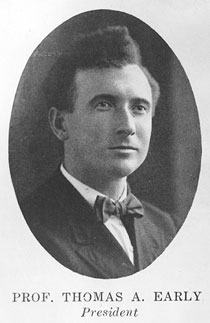 Thomas Alva Early (1916-1920)
Thomas Alva Early (1916-1920)
Thomas Alva Early was the first president of Tennessee Polytechnic Institute, formerly Dixie College. Though some thought TPI should be a “vocationally-oriented school,” many students came to TPI to become teachers, a coveted profession in rural Tennessee. Early began the push for TPI’s first bachelor of science degree in education, which the state approved in 1927.
- » More on Thomas Alva Early
Known for his extension work and his support of the military, Early held a war training school for draftees, established a rehabilitation program for injured veterans and brought a Student’s Army Training Corps to TPI in 1918.Early helped Tennessee Tech thrive with meager financial resources. Under his administration, the 1917 state legislature appropriated $100,000 for buildings, which led to the construction of South Hall and expansion of the administration building. Early took a personal interest in helping students who were struggling academically or financially. He passed a mandatory student work policy, requiring every student to work three hours a week to alleviate tuition and fee expenses.
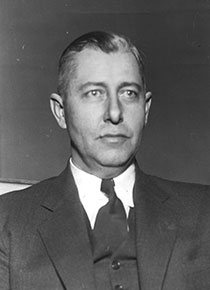 Quintin Miller Smith (1920-1938)
Quintin Miller Smith (1920-1938)
Quintin Miller Smith led TPI through the Depression, with budget cuts that eliminated courses and faculty. But there was growth during his tenure as well. Smith oversaw the construction of key campus facilities, including the science, engineering and home economics buildings; heating plant; machine and woodworking shop; president’s home; and dairy barn.
- » More on Quintin Miller Smith
Smith was known for advocating a college education despite a student’s poverty status. He set up special exams for prospective enrollees who lacked an eighth grade diploma and tried to help students overcome financial barriers to enrollment. Student activities also developed during Smith’s tenure. In 1925, students chose the Golden Eagle as their mascot. The music program grew, and by 1926, the university had an orchestra. Smith advanced TPI’s academic reputation by employing the first faculty members with doctoral degrees, establishing a four-year curriculum in education, and working toward accreditation. TPI awarded its first bachelor’s degrees in 1929.
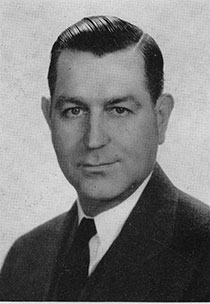 James Millard Smith (1938-1940)
James Millard Smith (1938-1940)
James Millard Smith set up a committee to revise the TPI curriculum, dividing the
curricula into two major divisions: arts and sciences, and professional and technical.
That restructure led to accreditation. TPI was admitted to the Southern Association
of Colleges and Secondary Schools in 1939. Enrollment had declined during the Depression,
but began to rebound in the late ’30s. In 1938, TPI accepted 100 students who received
financial relief through the Works Progress Administration. They could enroll for
up to 11 hours per term and work up to 100 hours per month at 27.5 cents per hour.
More students attended TPI through a special resident training project funded by the
National Youth Administration.
 William Everett Derryberry (1940-1974)
William Everett Derryberry (1940-1974)
William Everett Derryberry was the university’s longest-serving president and oversaw Tennessee Tech’s largest period of growth. When Derryberry took the leadership of the university in 1940, it had only 700 students, 31 faculty members and a handful of buildings. When he left in 1974, it had grown to 7,000 students, 276 faculty members and a 225-acre campus. A Rhodes Scholar and a native of Columbia, Tenn., Derryberry kept the university going despite dramatic drops in enrollment during World War II.
- » More on William Everett Derryberry
He oversaw the integration of the university in the 1960s. Under his tenure, the university’s name changed from Tennessee Polytechnic Institute to Tennessee Technological University. President Derryberry also is responsible for some of Tennessee Tech’s landmarks and best stories, including the golden eagle that now sits on top of Derryberry Hall and Dammit the dog. In 1952, three students stole the eagle statue from a local hotel to raise school spirit ahead of a football game against MTSU. The original owner eventually agreed to donate the bird to the university. Derryberry sent him $500 as compensation. Tennessee Tech legend has it that during a speech outside, a stray dog wandered past the president. When it wouldn’t move, Derryberry yelled “dammit” at it and later said that was the dog’s name. Dammit the dog is memorialized on the main quad. Under Derryberry’s watch, the U.S. Army established the nation’s first complete Signal Corps ROTC unit. In 1951, it was the largest Signal Corps unit in the nation. The ’50s were great years for Tennessee Tech athletics, with the football team winning its first Ohio Valley Conference championship in 1952. The football field and basketball arena are named for two coaches who served under Derryberry, P.V. “Putty” Overall and Hooper Eblen. Derryberry and his wife, Joan, left their marks on campus. Derryberry Hall is Tennessee Tech’s most recognizable building. Joan Derryberry wrote the Tennessee Tech hymn, and an art gallery bears her name. The couple established the prestigious Derryberry Award, which is given annually to a graduating senior who has exhibited characteristics that demonstrate potential for future service and effective leadership in American society.
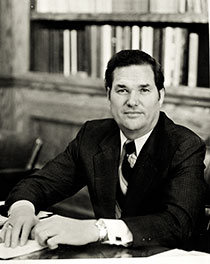 Arliss Lloyd Roaden (1974-1985)
Arliss Lloyd Roaden (1974-1985)
Tennessee Tech's academics and visibility grew during the presidency of Arliss Lloyd Roaden. The university created its four-year nursing curriculum, which produces a significant majority of qualified health professionals in the Upper Cumberland. In 1975, Roaden set up the Office of University Research. To attract distinguished research professors, Roaden created university research chairs in history, physics and engineering.
- » More on Arliss Lloyd Roaden
In 1984, the university received two state research centers of excellence — the Center for Manufacturing Research and the Center for Management, Utilization and Protection of Water Resources. Roaden also established the Office of University Development. By 1983, the university’s endowment exceeded $1 million for the first time. In 1985, Tennessee Tech had $1.5 million in contributions in a single year. With Roaden at the helm, Tennessee Tech’s commitment to the arts and music deepened. The university built the Bryan Fine Arts Building and acquired the Joe L. Evins Appalachian Center for Craft near Smithville, Tenn. The center promotes excellence in the American crafts of clay, fibers, glass, metals and wood. In 1985, Roaden left Tennessee Tech to become executive director of the Tennessee Higher Education Commission.
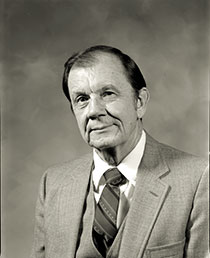 Wallace Samuel Prescott (1985-1987)
Wallace Samuel Prescott (1985-1987)
Wallace Samuel Prescott had a long association with Tennessee Tech. He came to TPI
as an engineering student in 1943, and he joined the faculty in 1946, teaching five
elementary surveying courses. He earned his master’s degree in 1952 at The University
of Tennessee and a Ph.D. at the University of Illinois in 1961. He became dean of
faculty at TPI in 1962. Prescott served as chief academic officer during part of Derryberry’s
presidency and as provost and vice president during most of Roaden’s tenure. Prescott
accepted the interim presidency after Roaden’s departure, coming out of retirement
to serve a university in transition.
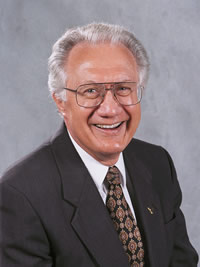 Angelo Anthony Volpe (1987-2000)
Angelo Anthony Volpe (1987-2000)
Angelo Anthony was the university’s seventh and the third longest-serving president in Tennessee Tech’s history. At the time of his retirement, his presidential tenure was longer than any other serving public university president. He was the first Tennessee Tech president to have a doctoral degree, with a Ph.D. in chemistry from the University of Maryland.
- » More on Angelo Anthony Volpe
During his tenure, the university completed a $21 million capital campaign, which included one of the largest one-time gifts in the university’s history. The university’s endowment grew from $1 million to $27 million. The athletic and academic programs also drew acclaim. On its way to Atlanta in 1996, the Olympic torch passed through campus to fanfare played by Tennessee Tech music groups. A Tennessee Tech student was selected to be the torchbearer to take it to its next destination. Volpe saw the construction of the recreation center, agricultural pavilion and the library, now named after him and his wife, Jennette. He also fought for funding to keep the Appalachian Center for Craft open to continue its educational mission. Today, the center offers concentrations in five areas, as well as artist in residence programs and community programs and classes. Under Volpe’s leadership, the university created two chairs of excellence and established the Gretta Stanger Center and the Leona Lusk Officer Black Cultural Center. The legacy of the Volpes continues in the architectural consistency of campus, the community relations fostered through Walton House receptions, and a prestigious annual scholarship for a freshman math major.
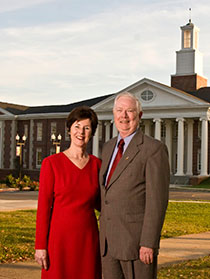 Robert Roy Bell (2000-2012)
Robert Roy Bell (2000-2012)
Robert Roy Bell became the university’s eighth president in 2000. He joined the Tennessee Tech faculty in 1976 in the College of Business, and he served as its dean from 1991 to 2000. Bell received his M.B.A. from the University of Florida in 1970, and he earned a doctoral degree in organizational leadership there in 1972. Bell honored the vision of Tennessee Tech’s founders to give Tennesseeans access to a quality, affordable education.
- » More on Robert Roy Bell
In 2010, 97.6 percent of new freshmen at Tennessee Tech were Tennesseeans. The university saw 11 straight years of enrollment growth under Bell, reaching a record high enrollment of 11,768 in Fall 2011. During Bell’s tenure, distance education programs grew more than 1200 percent. Online degree programs played a part in Tennessee Tech’s military-friendly status, as designated by G.I. Jobs and Military Advanced Education magazines in 2012. Like previous presidents, Bell insisted that Tennessee Tech remain affordable. Work-study programs and scholarships endowed by generous alumni are among the financial aid offerings available to Tennessee Tech students. In 2011, Tennessee Tech distributed more than $92 million in federal, state and institutional aid to students. During Bell's administration, the Tennessee Tech endowment grew to $59.5 million, more than double its value at the start of his presidency. During Bell’s tenure, Princeton Review named Tennessee Tech a “Best Value College” three times, and Institutional Research & Evaluation Inc. consistently ranked Tennessee Tech as one of “America’s 100 Best College Buys.” Bell set his sights on Tennessee Tech becoming a leader in education in the STEM disciplines — science, technology, engineering and mathematics. He garnered support for the construction of Ray Morris Hall to house the Millard Oakley STEM Center, which opened in 2010. In less than two years, the center provided hands-on learning experiences for more than 10,000 pre-K to college students, educators and residents throughout the Upper Cumberland. During Bell’s presidency, the university also secured funds and constructed the Nursing and Health Services Building, allowing the Whitson-Hester School of Nursing to expand its programs. New residence halls also were built under Bell’s leadership. The Cookeville community embraced Bell and his wife, Gloria, throughout his tenure. Gloria Bell worked to honor Tennessee Tech’s artistic heritage by bringing award-winning roses and local artwork to prominence in Walton House. Gloria Bell also helped design the university flag to represent the strengths of Tennessee Tech University — a proud spirit, a solid academic reputation and a foundation of character and commitment that are indicative of Tennessee Tech’s culture.

